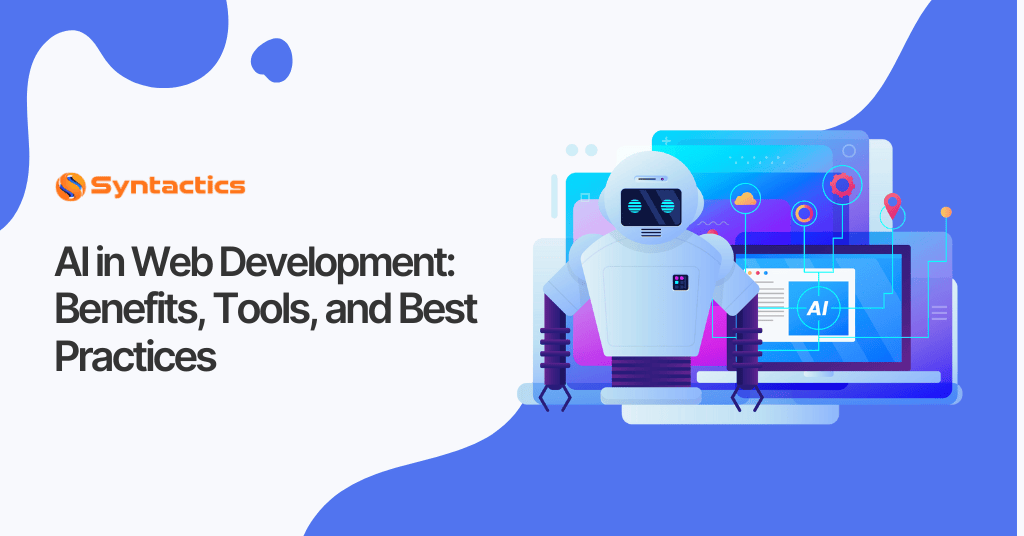
AI in Web Development: Benefits, Tools, and Best Practices
Explore the impact of AI in web development for faster, user-focused site creation. Know its benefits, tools to use, and strategies for optimization.
Artificial Intelligence (AI) has fundamentally reshaped several industries, and web development is no exception. Tasks that once required extensive manual effort and specialized expertise can now be simplified by AI. From intelligent code generation to performance optimization, AI in web development enables teams to build faster, smarter, and innovative digital products.
According to the NEW Artificial Intelligence Statistics, 35% of businesses use AI to address labor shortages. This trend highlights AI’s growing role as a practical solution to modern workforce and efficiency challenges. It helps the development team to do more with fewer resources while maintaining high-quality output.
TABLE OF CONTENTS
Understanding the Basics of AI in Web Development
Difference Between Traditional vs. AI-enhanced Web Development
Top AI Tools for Web Developers
Best Practices for Integrating AI in Web Development
FAQs About AI in Website Development
Key Takeaways
- By 2027, 80% of the development projects will use AI to accelerate coding, testing, and prototyping, reducing time-to-market and enhancing team productivity. [Gartner]
- AI-enhanced web development adapts in real time.
- Popular AI tools can boost efficiency and reduce technical query resolution time, supporting rapid development cycles.
- Adopting AI for quality assurance, design, and deployment can reduce software development costs by up to 30%. [McKinsey]
Understanding the Basics of AI in Web Development
In reality, users are already engaging with AI on a daily basis, from experimenting with tools like ChatGPT to leveraging machine learning for content creation. Given its remarkable capabilities, AI and web development form a powerful combination. This technology excels at processing large datasets, making data-driven decisions, and delivering precise predictions.
Here are the key areas where AI directly impacts the development workflow:
Code Generation, Optimization, and Completion
Tasks such as writing, refining, or completing codes, can now get AI assistance. Tools like OpenAI’s Codex can help generate snippets from natural language prompts, while GitHub Copilot accelerates coding to significantly boost productivity.
UI/UX Design Creation and Optimization
AI can also streamline design using tools like Murf AI, which generates templates and visual assets. Other web experts use Uizard to transform sketches into refined, interactive designs. These tools handle repetitive creative tasks, allowing the team to focus on strategic and user-centric decisions.
Automated Testing and Predictive Analysis
While most of the development team prefers traditional testing, AI can assist developers by:
- Automating quality assurance processes;
- Predicting deployment issues before they occur, and
- Analyzing user behavior to fine-tune the website’s performance.
This proactive approach speeds up development and helps deliver a more stable and user-friendly digital experience.
Deployment Automation, Version Control, and Code Review
In complex projects, AI can be integrated into CI/CD pipelines (Continuous Integration/Continuous Deployment) to perform the following tasks:
- Automate code deployment;
- Recommend version control strategies, and
- Track modifications seamlessly.
Additionally, AI-powered code review tools can help developers to analyze codebase in real-time, catch bugs, flag security vulnerabilities, and recommend performance improvements before deployment. This ensures cleaner code, minimizes post-launch issues, and maintains quality standards while saving valuable time.
Difference Between Traditional vs. AI-enhanced Web Development
Despite the fact that traditional methods rely on explicit programming rules, AI-enhanced web development learns from data, adapts instantly, and handles complexity at scale.
To better understand these two approaches, check out this comparison chart.
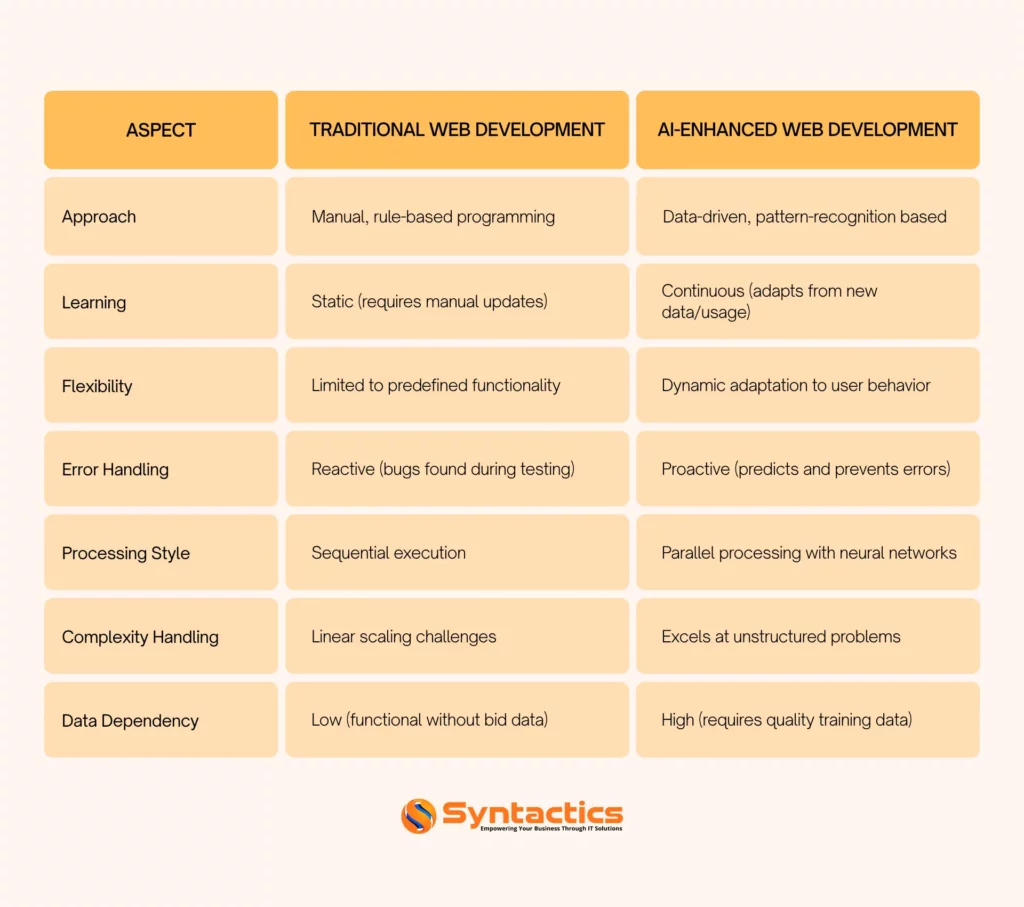
For developers, AI takes over repetitive tasks like testing and generating boilerplate code, allowing them to focus on innovation and problem-solving. For businesses, on the other hand, it delivers faster deployment, and predictive error handling can lead to lower development costs.
AI is not a replacement for developers but a strategic enhancement, enabling teams to innovate faster and more efficiently. They’ll become the co-pilot for modern website development.
Key Benefits of Using AI in Web Development
Using AI for website development offers a plethora of advantages. Let’s take a look at the major ones.
- Efficiency and Speed. AI can automate time-consuming tasks, such as coding, debugging, and quality assurance. This accelerates the web development process and frees up time for innovation.
- Scalability. AI supports building flexible and scalable architectures that can adapt to user growth without compromising performance.
- Cost Reduction. Since AI can automate labor-intensive processes, businesses can lower both development and operational costs.
- Personalized Impressions. AI also customizes content and interfaces based on user behavior, preferences, and interactions.
- Enhanced Engagement. Advanced chatbots and virtual assistants can enhance communication by offering instant 24/7 support and making users feel valued and engaged.
- Better Decision-Making. AI equips developers and businesses with data analytics and user insights to guide development solutions and UX improvements.
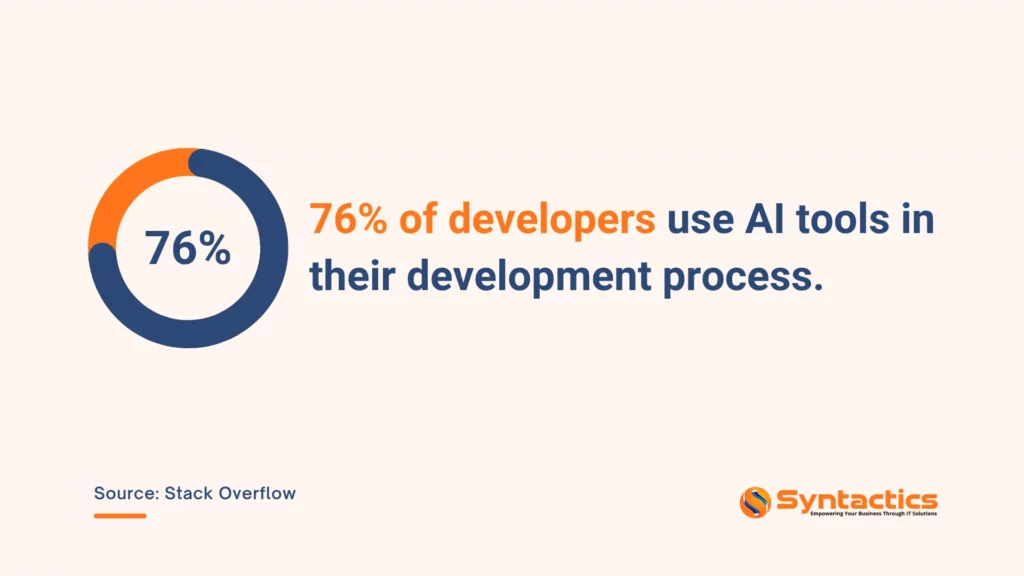
Source: Stack Overflow
Top AI Tools for Web Developers
Integrating AI into website development can automate certain processes, enhance functionality, and turn complex processes into intuitive workflows.
Below are the essential tools every modern web developer should explore:
ChatGPT and OpenAI Codex
ChatGPT accelerates ideation and troubleshooting by generating human-like responses to technical queries. Its sibling, OpenAI Codex, also translates natural language prompts into functional code snippets for languages like Python and JavaScript.
These tools can reduce research time and help developers prototype faster with human refinement for precision.
GitHub Copilot
Acting as an AI pair programmer, GitHub Copilot suggests code completions and entire functions in real-time. Integrated directly into VS (Visual Studio) Code, it learns from your coding patterns to accelerate development. By automating routine tasks, developers can focus on solving complex problems instead of writing boilerplate code.
v0.dev
vO.dev revolutionizes frontend development by converting visual designs into clean, responsive code instantly. Upload a UI mockup, and it generates production-ready HTML/CSS, eliminating manual translation from Figma or Sketch. This tool is best for rapid prototyping and bridging the gap between designers and developers.
Cursor
Cursor streamlines code editing with AI-powered refactoring and documentation. It analyzes your repository to suggest optimizations, detect vulnerabilities, and auto-generate comments. For legacy systems or large codebases, the Cursor acts like an intelligent assistant that clarifies logic and modernizes structure.
WindSurf
WindSurf enhances accessibility compliance by automatically auditing websites for WCAG (Web Content Accessibility Guidelines) standards. It identifies contrast issues, missing alt text, and keyboard navigation gaps, then suggests fixes. This tool prevents costly accessibility lawsuits while ensuring your site serves all users inclusively.
Claude.ai
Claude.ai excels at technical documentation and API integration support. Feed it a code snippet, and it generates clear usage guides or troubleshooting steps. Developers rely on Claude to maintain consistent documentation across projects, reducing onboarding friction for teams.
Figma with AI Plugins
Figma offers AI plugins that streamline the design process by generating automatic color palettes, layouts, and icons. This tool enhances team collaboration and significantly accelerates design workflows.
Adobe Sensei
Adobe Sensei is Adobe’s intelligent AI platform, integrated into creative tools like Photoshop and XD. It enables features such as auto-cropping, intelligent image retouching, and personalized design recommendations, helping designers work more efficiently and creatively.
Canva’s Magic Design
Canva’s AI instantly converts text prompts into polished graphics, social media assets, and website banners. Developers without design skills use it to create professional visuals for landing pages or documentation, ensuring brand consistency.
Google Analytics (GA4)
Google Analytics now leverages AI to predict user behavior, flag traffic anomalies, and identify high-value audience segments. Its automated insights help developers prioritize features that boost engagement, turning raw data into actionable optimization strategies.
Best Practices for Integrating AI in Web Development
With AI continuing to change the digital landscape, integrating it into your website development processes can help you stay competitive. By strategically adopting these best practices, you can build websites that captivate users and drive tangible business success.
1. Utilize AI Chatbots for 24/7 Support
Transform customer service with advanced chatbots. They can handle routine queries instantly, route complex issues to humans, slash support costs, and boost satisfaction, leading to greater loyalty and retention.
2. Personalize with Machine Learning (ML)
Analyze user behavior and deliver hyper-relevant content recommendations using Machine Learning algorithms. This will drive deeper engagement, increase conversions, and build lasting brand loyalty.
3. Optimize Media with AI
AI can automatically enhance images and videos. It reduces file sizes for faster loading, improves visual quality, and ensures a smooth experience across all devices and connections, boosting performance and engagement.
4. Deploy NLP for Smarter Search
Integrate Natural Language Processing (NLP) to understand user intent and context. As a result, you can:
- Deliver precise and relevant search results;
- Streamline the user journey;
- Lower bounce rates, and
- Increase conversions.
5. Generate Content Efficiently
You can also leverage AI for drafting product descriptions, blog posts, or updates. It saves you significant time and resources while maintaining consistency, freeing up your team for higher-value creative work. But ensure to have human oversight and expertise for quality and refinement.
6. Gain Insights with AI Analytics
Utilize AI-powered analytics tools to uncover deep, actionable insights into user behavior and pain points. Use data insights to fine-tune your website and drive business growth.
7. Test and Optimize Continuously
Rigorously monitor and test AI-driven features to ensure they meet quality, security, and performance standards. Constant optimization guarantees a seamless, high-performing user experience that delivers results.
Final Thoughts
The role of AI in web development is set to expand dramatically, offering businesses the ability to build innovative, more personalized, and highly efficient websites. From AI-driven chatbots and advanced data visualization tools to predictive development and real-time user personalization, artificial intelligence is transforming how companies engage with their audience.
With AI’s powerful capabilities, the future of web development promises to be more innovative and user-focused than ever before. Explore how AI can elevate your web development strategy and start integrating business-specific AI solutions with our web design and development experts in the Philippines today.
Elevate Your Brand In the Digital Landscape!
- SEO: Boost your rankings and drive organic traffic.
- Content Marketing: Engage your audience with content that converts.
- Social Media Management: Build your brand and connect with the right people.
- Paid Ads: Maximize ROI with data-driven advertising campaigns.

FAQs About AI in Web Development
Is AI replacing human developers?
Definitely not. AI enhances productivity by handling repetitive tasks, like testing and code generation, freeing them for complex problem-solving and creativity. Human oversights are still essential for strategy, ethics, and quality control.
Can AI improve website performance?
Yes. AI optimizes images and videos for faster loading, personalizes user experiences, predicts traffic spikes, automates testing, and enhances security, boosting speed, engagement, and conversions.
How do I start integrating AI into my website?
Start small and use AI tools for chatbot support, basic code generation, or analytics, and then scale with more advanced tools. Get in touch with our web experts for a strategy call.



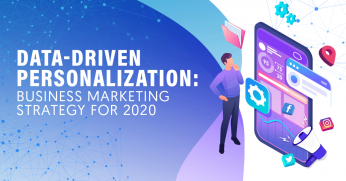
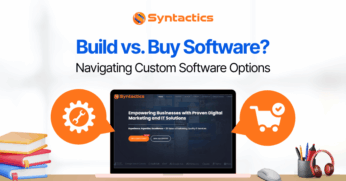
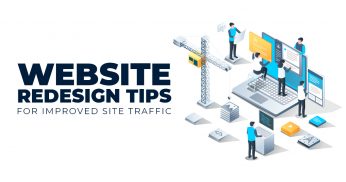
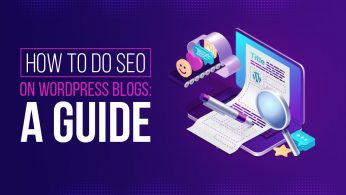








Comment 0